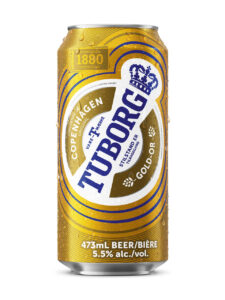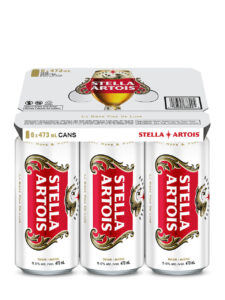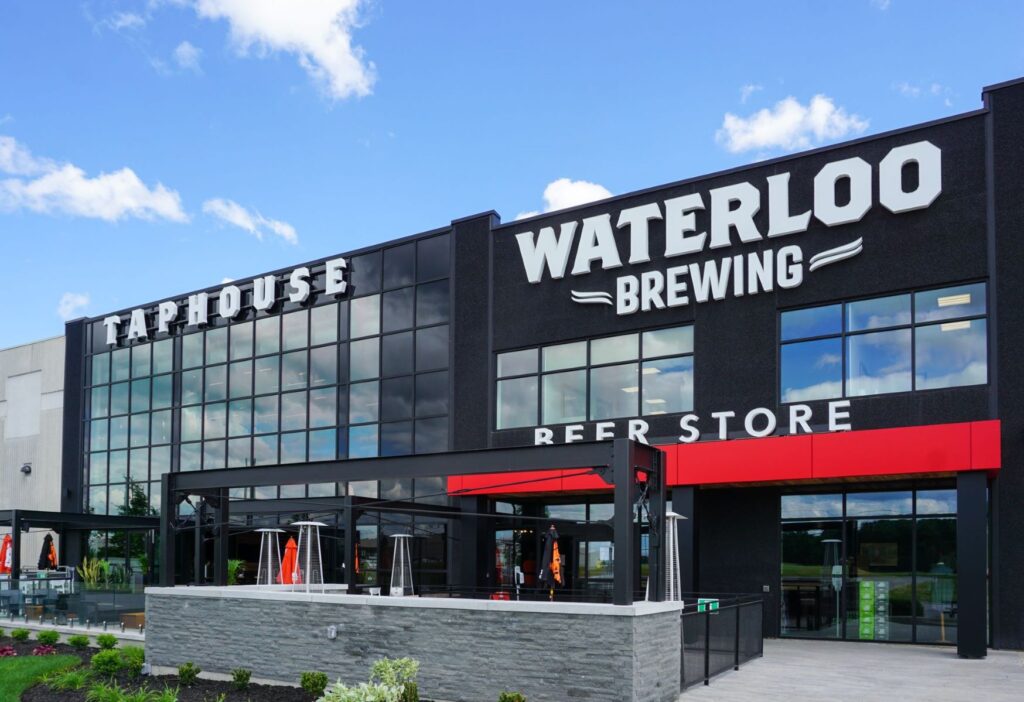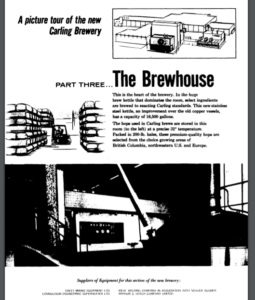2024 has been an interesting year for Ontario’s beer market. We’ve had closures, although not quite as many as you might imagine. We’ve had mergers and acquisitions, some of which make no sense. We’ve had the odd brewery open in the province of Ontario, which is not as ludicrous as you might assume if you believe that the owners have paid attention to cautionary examples.
That being said, the biggest and most significant thing that has happened in 2024 is the partial collapse of imported beer.
At the beginning of 2024, I had to revise the manner in which I’m teaching beer styles at George Brown College for a couple of reasons. For one thing, English styles are very hard to acquire on an ongoing basis. There are breweries in Ontario that produce a mild, but probably not year round. If you go and look at the number of English beers and ciders available through the LCBO, it’s sitting at 24. I’m going to assume that if you’re reading this, you’re going to discount Crest Super entirely; a beer which exists entirely for the benefit of the under the bridge crowd.
Looking at my aggregator spreadsheet, I can paint you a picture of the timeline upon which this happened. In 2020, the LCBO had 380 imported listings. This decreased to 318 in 2021. International supply chains were probably being used for more important things than beer. Realistically, however, that’s just the moment in time that had the most precipitous drop.
Between 2017 and 2023, the volume of imported beer at the LCBO dropped by about 40% from 1.56 million hectolitres. Over the same time period, the amount of beer moving through the channel did not really change by a huge amount. In fact, the amount of domestic beer being moved through the LCBO increased by approximately the amount that imports dropped.
Of course, there have been structural changes to the beer market. While we can’t blame convenience stores as they didn’t exist yet, the fact that the LCBO had become wholesaler to 450 grocery stores during that period might go some way to explaining how the LCBO stole 11% of the Ontario alcohol market from The Beer Store as a chain.
Of course, the beer market is down overall. Down about 1.5 million hL from the high point in 2017 at 9,075,410 hL. The pie is smaller. That being said, the import market got it worst of all, losing 10% volume year over year since 2022.
This has led to an interesting development at The Beer Store: the International section.
It happened gradually. I can’t tell you the date, but I know that it was Jamie Drummond that brought it to my attention. He had been a lifelong Lowenbrau drinker, and a dedicated one at that. He got in touch one day to point out that it didn’t taste right. Of course it didn’t. It was being brewed in London, Ontario at Labatt.
Now, this was nothing new. They’d been brewing Stella Artois in London, Ontario for a while. In fact, brewing under contract in Ontario is nothing new. Brick used to brew Andechs. Henniger and Amstel both occupied the Hamilton premises of Collective Arts long before Labatt decommissioned the plant and filled the piping with concrete.
Over time, I began to get the sense that the walls were pushing in on the import section. One year, maybe 2019, I added Spaten to the beer styles course at George Brown as the ur-example of Munich Helles, but as soon as I opened the can it was wrong. I hadn’t noticed that it was 473 ml, but I surely noticed the difference in aroma within seconds. You guessed it: London, Ontario.
I’ve been doing sensory work as a professional for about a decade and a half at this point and sometimes I get people telling me that the big brewers are geniuses because they can produce identical beer at different breweries across the planet. These people are either delusional or very charitable.
———
At the moment, we’ve got something like 30 separate beers in the market with international branding that are actually brewed in Canada. Not all of them are listed as part of The Beer Store’s International Section. The key to discovery on this is that the cans are 473 ml.
Labatt is making Stella Artois, Corona, Corona Light, Lowenbrau, and Spaten. Sleeman in Guelph is making Sapporo and Sapporo Black (the 650ml tin is still an import). Moosehead is making Grolsch. Amsterdam is making Faxe Premium, Faxe Amber, and Faxe Extra Strong. Waterloo is making Carlsberg Danish Pilsner, Carlsberg Light, Holsten Premium, Holsten Festbock, Holsten Maibock, Kronenbourg 1664 Lager, Kronenbourg 1664 Blanc, Kronenbourg 1664 Rose, Tuborg, and Tuborg Gold. I’m not counting Landshark because it has always been a contract brand.
Equals is making Lion Stout for the Ontario market. Innis & Gunn Original, Lager, and Caribbean Rum Cask are produced at Brunswick Bierworks in East York. Molson produces Sol, apparently under license from Heineken, and Madri Excepcional. I suppose if you wanted you could lump in products from Blue Moon and Hop Valley.
The majority of the movement in this sector has been from large European, specifically Danish breweries making purchases within the Ontario market. Carlsberg purchased Ontario’s first craft brewery, Waterloo for something like $144 million. This is peanuts when you consider that their profit in 2023 was about 11.1 billion Kroner or about 2.231 billion Canadian. Royal Unibrew purchased Amsterdam Brewing for about $48.5 million. Amsterdam had really grown over the previous decade. Royal Unibrew has similarly been expansive, having acquired ten companies since 2021. They have also acquired the Bruce Ashley Group in order to get boots on the ground in Ontario for sales.
The majority of this change is due to the war in Ukraine driving prices for production and logistics up in 2022. By Q2 2022, energy costs had increased by a factor of something like 2.4. It’s a humbling consideration for Ontario’s beer market that the decision to purchase two of our largest independent breweries comes down to an inflationary correction measure, but here we are. It was cheaper to buy Waterloo and Amsterdam than make beer in Denmark and ship it to North America. Innis & Gunn faced similar issues in dealing with the UK market for production. The input costs had skyrocketed to the extent that the construction of their brewing project at Herriot Watt had been scuppered.
——–
I’ve never seen anyone else mention the International Section of The Beer Store’s website. It’s not particularly hidden, and while it doesn’t include everything that is being brewed with International livery in Canada, it does include most of them.
Does anyone care? You would think that the average customer would assume that if they’re buying a Carlsberg or a Stella Artois or a Faxe, they might care about the fact that they’re brewed in Ontario rather than being imported. Of course, the package size is different, and the majority of these products are labelled as being products of Ontario on the can. Whether the average punter is actually looking at the can or not is questionable. If they do, the likelihood is that they’ll find the idea that their import brand is not imported is worth comment.
There is a significant amount of pushback in the review section of the LCBO’s website for these transplanted products. They tend to be polarizing, with credulous beer drinkers awarding five stars and saying everything is fine (frequently with typos) and dedicated brand loyalists excoriating the products (frequently with typos).

Tuborg, which has been launched in Asia with some success, splits down the middle with two one star reviews and two five star reviews. Konstantin says “TUBORG GOLD used to be great when imported from Europe. The can was 500 ml , The price was lower and the taste was amazing. The new 473ml cans are bottles in Canada and somebody totaly screwed the taste. I hope the people of Carlsberg canada fix this soon,” while Colin A says five months later that there has been improvement; “It was terrible when they first stated brewing it in Ontario but now it’s very good.”
It’s emblematic of the problem of familiarity. Let’s say you drink a case of Tuborg a month and you’re very familiar with it. It’s cheap and cheerful and you like it. You don’t need to be a sensory expert to know that it has changed. You drink more of it than the tasting panel trying to replicate the recipe from Denmark, so of course you’re going to know that it is different. For every one of these beers, you’re going to have drinkers who are upset by the change. Those people are presumably the largest audience for the product and the period in which there is a learning curve might put them off.
Sometimes, it doesn’t look as though the learning curve has an end in sight. Stella Artois, brewed in London since 2020, has 19 reviews. Former Stella Fan wrote “Just drank a 500ml can brewed in Belgium followed by a 473ml can brewed in Canada. Same price. NOT the same beer. The locally brewed beer is not a Stella. It is just an average beer now,” and was upvoted 89 times for it. John K, seemingly a presentational purist wrote, “Stella is always my go to of Euro lagers. Gotta have it in a chalice though,” and was downvoted 72 times for his trouble. Those were four years ago. More recently, Raiders776 wrote “The best tasting beer on the market! a 1000 times better than Corona!” which is something of an own goal since they’re made at the same plant. Bakin, the most current reviewer writes, “Garbage. Loved the import, but when it started to be shipped out of London Ontario I lost all faith in the Multinationals to deliver a decent product.”
Stella Artois really took off in Ontario in 1996 thanks to the Oland Specialty Beer Company, which was a Labatt project and which introduced the elaborate pouring ritual the beer is known for. That gimmick was so important to the brand they had a pouring competition. I judged it, once upon a time. It was positioned as a premium product and required that servers be trained on it. It’s quite difficult to match the sense memory people have for that on different equipment and with different processes and in a different service format and with different personnel brewing it.
Maybe we can remove the familiarity bias by looking at an international brand that is completely new: Madri Excepcional.
Unlike legacy brands like Carlsberg and Sapporo which have long and storied histories, Madri Excepcional was made up out of apparently houndstooth whole cloth and is described as a collaboration between Molson Coors and La Sagra. It is described as having all the taste characteristics of a modern European lager, which is to say they’re ripping off Estrella Damm right down to the colour of the livery. The collaborating brewery isn’t even from Madrid. It’s from Toledo, whose name hasn’t travelled very well.
The press release from January of 2024 says, “The heart and soul of this brand lies in the magic of contemporary Madrid: modern, progressive, and urban. Yet, it never loses sight of the rich culture and traditions cultivated in Spain, over thousands of years. This fusion of innovation and heritage is what sets the brand apart, making it truly Excepcional. The brand is embodied by the “Chulapo”, representing a group of people from 19th century Madrid, famous for their elaborate style and cheeky attitude. This distinctive figure takes center stage on the product packaging and in communication materials. Today, the term is often used to refer to the people of Madrid, and the spirt of the original Chulapo’s which continues to live on within them.”
Having been introduced in 2020, it’s one of the best selling beers in England, a nation which voted themselves out of Europe to disastrous economic consequences and then decided to vote with their wallets to drink a product made in Burton-On-Trent which vaguely reminds them of vacations in Tenerife and Benidorm that are no longer financially accessible to them. They don’t know a Chulapo from a Chalupa. Thicker than two short planks and unable to afford one of them.
Our version is made at the Carlingview plant in Toronto. Reception has been mixed. Beerylady, clearly an anglophile still buzzing from seeing Big Ben writes, “Had this in England last year where it was SO popular. Really excited to see it in Canada now!!” Harvinder, who has not been to Borough Market recently writes “while the taste is decent, I’m disappointed by the misleading branding. It’s positioned as a premium import from Spain, but it’s actually brewed locally in Canada. If you’re expecting an authentic Spanish beer experience, this isn’t it.” Real Sports, who are in the retail rather than reviewing business, are currently charging $14 before tip for a 20oz pint of beer imported from Etobicoke. I’m going to guess they lean towards five stars. Personally, I would call it cynically exploitative, but what do I know?
—————–
It’s clear that global market pressures are coming home to roost. Craft Beer in Ontario is always competing against cheap and cheerful imports and consumers who are entirely within their rights to ask why they would pay up to two dollars a can more for locally made small batch product when DAB is available at the LCBO. It’s one of the defining qualities of our market that the LCBO has been terrifically successful at negotiating pricing for imports.
Energy crises in Europe and the exponential rise of transatlantic shipping costs make the purchase of local breweries by international conglomerates downright sensible. If The Beer Store were going to exist beyond 2027, they might have to revisit ownership stakes now that Carlsberg and Royal Unibrew are present and expanding their marketing within the province. Between those two breweries, they probably make more volume than the entire Craft segment.
The question is whether the fog of war surrounding what is sure to be a hotly contested marketing period in the wake of expansion to convenience stores will shake consumer confidence in the segment further. What is the average punter getting when they buy a beer besides tipsy? It’s not a lager made in Copenhagen or Liege or Mexico or Madrid. It’s a locally fashioned simulacra. Can one be said to be a sophisticate because of their discerning choice of an international brand if that brand isn’t actually imported? The marketing dollars are going to speak and eventually the question is going to be one of authenticity.
Because beer is almost never about beer.



Old Stule Pilsner ftw!
Just like it tasted in Lethnr8dge
Go home, Bealsy, you’re drunk.
Great insights with many truths.
Leave it to the importers to drop a killer standard like Sierra Nevada from their inventory.
Ontario is a mess for beer right now but it’s reason to drink more!
Great article, thanks Jordan.
Lowenbräu has had an affair with two Canadian breweries as it used to be made by Molson when I worked there in the 80s. All that blurb about Madri is laughable. In fact it’s verging on complete lies. If it has an accent on the “i”, and I believe it does, I’m deliberately leaving it out. Doesn’t have the history of Lowenbräu.
Oops… Omitted the umlaut over the “o” on both occasions with the Löwenbräu…
If I’m honest, I’m not sure it’s earned the proper spelling.
Jordan:
Very interesting piece. Great stuff. Is it just me, or does the Tuborg Gold in Waterloo taste vaguely like the old (really old) Brick Lager? Happy new year.
*from* Waterloo
I’ve got feelings (surprise). On one hand, why ship water that far? On the other, I’m am disappointed that there is a detectable difference as to where these products are brewed. I’m going to suggest the differences are in fact deliberate, as in catering to local market preferences. First of all, most of the examples here are industrial scale mass products in their home countries (nothing special, but highly consistent). Are you suggesting that many of the great brew masters and chemists working in these contract breweries can’t duplicate a recipe they have been given? Knowing many of them, I call B.S. on that. Even as a home brewer I have been told that I’ve made convincing copies, and I’m a hack.
I’m less easy going on the transparency (or lack of) in the marketing. I don’t see a flat out lie, but it sure seems hazy.
I guess I’m being a snob here, but none of these beers are all that great a loss. Do I care that they aren’t true to their roots? Not really. I mean, they’re fine I guess when I’m hanging out with my friends under the bridge. (don’t judge)
There is some suggestion that things are brewed for market preference. I’ve heard stories for instance that when Lowenbrau was brewed by Molson long ago, they made a batch to the German spec when the brewmasters flew in from Germany to test the beer and then brewed for preference the rest of the time and no one was the wiser.
But also, I know a lot of brewers and chemists and sensory people and I’ve tried a lot of beers over the years that were market adapted. It’s not the recipe. Equipment, tank geometry, water, processes, personnel, attitude towards the work, etc. You work with what you’ve got. It’s not that it is impossible to brew something identically. But they’re not doing it. So either they’re not doing it intentionally or they’re not doing it unintentionally. The question then becomes, “are brewers at six or seven separate breweries intentionally changing the recipe to 30 different brands?” It’s not as though they’re uniformly talented. I think it’s simply more difficult than you’re making it out to be and that perhaps the brewers of Ontario just aren’t as good as a pro at an industrial European brewery.
The point about shipping water made by Rein is a good one, except when one considers that a lot of Perrier and Evian is also being shipped across the Atlantic. The taste differences in the beer is a fairly complicated subject. What I do feel is that if you can’t brew a near exact facsimile of a European beer in Canada, then don’t bother. However, the thing that really, really irks me is that on the 473 ml can of Tuborg that I looked at today, it says, in a banner just to the left of the big Tuborg brand font, “Copenhagen Original”. I have a real problem with that.
You are probably correct about the equipment. I guess I am judging by some of the brewers who, under their own operations, brew consistently across other territories. For example Sierra Nevada in the US. I’d be hard pressed to tell which facility one of their beers comes from, and those are beers with character, not ones easily interchanged with other macro templates. They likely clone the whole brewhouse to do it.
It was said for years (and I imagine it’s still true) that Guinness targeted beers for local markets. At least that seems honest to me. My guess is that might be going on with a little less transparency with some others.
The one that really made me laugh was when Fat Tire contracted to Canada. It’s never been a beer I much liked, but the version they had contracted here (was it with Steamwhistle?) took garbage to a whole new low, compost in fact. I can’t believe any self respecting brewery would have compromised their brand so much by not keeping an eye on that.
As for those Euro brands, honestly, I don’t mind looking like a hoser and just having a Blue. Perfectly passable. Don’t need the crest.
Sierra Nevada are an interesting case. I walked that facility back around 2014 or 2015 when they moved into Mills River. They designed it to replicate their product, but you gotta believe they had it down to a bespoke rail siding for grain and hop bale storage for the whole cone. It’s iconoclastic to begin with. Ain’t no one doing that.
Guinness is targeted for local markets for sure, but the stuff we get is from Dublin. Labatt used to make the Export version, but it’s lower alc now and also from Dublin. In 1998 it tasted like pine tar.
Fat Tire was a complete cluster. It wasn’t just that you had Steam Whistle making it. They would have gotten there with a little more learning curve. It’s a different style and yeast than they’re used to. It’s that they changed the American recipe halfway through that tenure and dumbed it down there and here. I can’t blame Steam Whistle for that. I had a walking tour with some New Belgium folks about that time, and although they were lifers, they sort of agreed. Voodoo Ranger was better.
Someone privately suggested the difference might be high gravity brewing. I think it might be a lack of decoction. Some of those legacy beers are decocted in Europe. Those are steps North American brewers would favour.
Agreed it is no great loss, and in the long run maybe a boon to strugglnng craft brewers here. Knowing a few employees at the contract breweries i can substantiate the struggles they have in duplicating recipes, to date at least.
I just want to say thank you for another interesting article!
It is a good 25 years since I was a beer judge and writer. Flash forward, while I have no idea which party is contract brewing what beers, I trust my BJCP-educated palate. Not on what I like or don’t like, but the detailed organoleptic profiles of various beers. Thank you, Jordan, for helping me understand why several of the beers I drank regularly, and enjoyed because they were well made and tasty, 15+ years ago, are total garbage these days. In particular – Tuborg and Carlsberg. Today, they are both “factory lagers” that have absolutely nothing defining or pleasant smelling/tasting about them; tasted blind, I, and expect many other beer drinkers, would peg as a Molson or Labatt lager. Independent of that, they’re just not nice to drink. And we all have one liver, so every beer counts.
Another beer that is contract-brewed and nasty tasting is Lagunitas IPA: pallid, flavourless, no hop aromas or bitterness. I believe a hop extract is used and not real hops. Oy vey. Factory food, made at scale, as cheaply as possible. I was at the Oland launch party and it was a pleasure to taste Hoegaarden on tap, poured properly, in a proper glass. The stuff in Ontario in cans is a flavourless and characterless wheat beer. Wouldn’t even make soup with it.
Having recently grabbed cans of Smithwicks, it was an absolute pleasure to taste a proper Irish red ale – proper water profile, aromas and flavours, fantastic depth – clearly Guinness realizes to control quality, you cannot allow local contract brewing everywhere for Guinness or Smithwicks. I remember the Guinness that Labatt made – tastes like gas station coffee from the day before that the night staff forgot to throw out.
Very informative article, Jordan, and a pleasure to read.